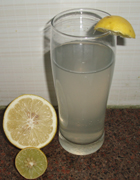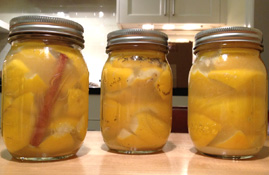Selection and storage
The peak season for lemons is April through August, though they can be available in stores all
around the year. Choose big, plump, firm fruits that feature heavy for their size. Choose vibrant, bright yellow fruits imparting a fresh citrusy aroma that can be appreciated when you gently roll your finger over them.
Avoid dark-green colors as they are immature and would not be as much juicy. Also, avoid those with dark spots, overtly soft or spongy as they tend to perish early.
At home, store them in a plastic pouch and place them inside the refrigerator where they keep well for up to a week. Store freshly squeezed lemon juice inside the freezer compartment for later use. Store dried zest in a cool, dry place in an air-tight glass container away from moisture.
Preparation and serving methods

|
| Fresh lemon juice. |
Wash them in cold water just before using. Gently scrub if using the peel to obtain the zest. In general, cut it into halves to squeeze and extract juice. One may also get the help of juice-extracting appliances.
Whole fruit, zest, peel as well as its juice are the most sought-after ingredients in a variety of cuisines worldwide.
Here are some serving tips:

|
| Moroccan style preserved lemons. Photo courtesy: chuck b. |
-
Lemon slices/wedges served as a garnish in salads and dishes.
-
Apart from regular usage as a flavoring item in beverages or lemonade, they are also employed in confectionary like pies, cakes, bread, pastry dough, and marinades.
-
Its juice can be stored frozen for later use.
-
The outermost part of the rind is grated using a zester to produce lemon zest, which also has many culinary values for its flavor-rich oil glands.
-
Iced lemon tea is a refreshing drink.
-
Dried preserved lemons are employed as a condiment in Persian cuisine.
-
Lemon/lime pickles are a favorite side dish in the Middle East, India, Pakistan, Morocco, etc.
Safety profile
Lemon juice is very low in pH, about 2.0-2.2. In some sensitive people, its sour, acidic juice may sometimes elicit a burning sensation
if come in contact with mouth, tongue, and lip ulcers. Also, if taken in large amounts, may exacerbate acid-peptic disease and stomach ulcer conditions. (Medical disclaimer).
≻≻-You may also like to read- Limes nutrition facts.
≻≻-Back to Fruits from Lemon. Visit here for an impressive list of all varieties of fruits with complete illustrations of
their nutrition facts and health benefits.
≻≻-Back to Home page.
Further reading and Resources:
-
Stanford School of Medicine Cancer information Page- Nutrition to Reduce Cancer Risk.
-
JN-The Journal of nutrition– The Hypoglycemic Effects of Hesperidin and Naringin Are Partly Mediated by Hepatic Glucose-Regulating Enzymes in C57BL/KsJ-db/db Mice.

